Cards In This Set
| Front | Back |
|
Phylum Mollusca
|
Ex. Snails, slugs, shellfish, octopus, squidOpen circulatory system (except cephalopods) and no segments.
|
|
Cantareus aspersus
|
Brown Garden Snail. Herbivorous (feeds on terrestrial vegetation)
|
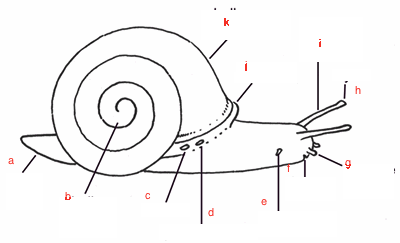 External anatomy of snail |
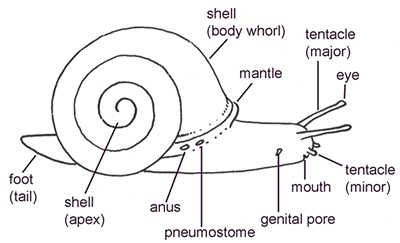 A) foot - glands secrete mucus (for locomotion, to lay down chemicals, reduce water loss)b) Shell - CaCO3 and proteins secreted by mantle. Most gastropods have dextral (right handed) coiling.Have growth rings. Operculum= lid that seals snail in shell when they retract (our snail doesn't have this)c) Anus - obviousd) Pneumostome - Pore for the opening of the "lung"e) Genital pore - f) mouthg) Inferior tentacles - used for olfaction (smell/taste) and primarily to detect chemicals on groundh) Eye - on superior tentaclesi) Superior tentacles - primarily for olfaction (smell/taste) and primarily to detect chemicals in airj) Mantle - k) shell |
|
Snail locomotionWhat did Canterus use?
|
Waves: monotaxic - wave of contractions extend across width of foot (our snail)orditaxic - alternates between right and left sidesandDirect - posterior to anterior (lift posterior forward first) (our snail)orRetrograde - anterior to posterior (life anterior forward first)
|
|
TaxisWhat was Canterus' reaction? Why?
|
Geotaxis - movement relative to gravity (snail=neg.)Phototaxis - movement relative to light (snail=neutral)Chemotaxis - movement relative to a chemical source (varies but mostly positive)Rheotaxis (in fish) - movement relative to water currents
|
|
Mollusk respiration
|
Aquatic: gillsTerrestrial: Exchange gases across mantleboth most be moist.Pneumostome: opening to "lung"
|
|
Reproduction in gastropods+
What is the function of a "love dart"? |
Most hermaphrodites. They release pheromones to attract others. Exchange sperm packets. Snails are polygamous so love dart is used to ensure that the sperm have a better chance of surviving by injecting a mucus.
|
|
Phylum Arthropoda
|
Bilateral symmetry, segmentation, cephalization (sense and control organs concentrated in anterior), exoskeleton, jointed appendages
|
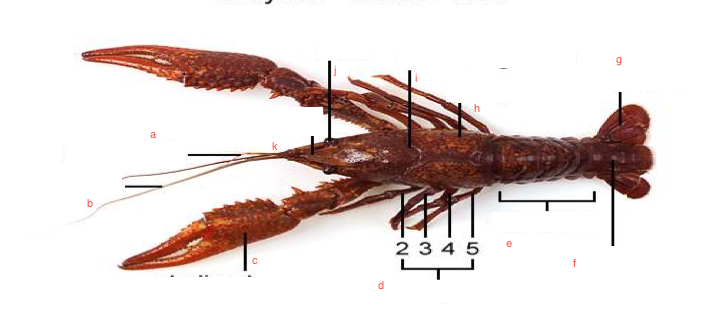 The CrayfishExternal Anatomy - Dorsal |
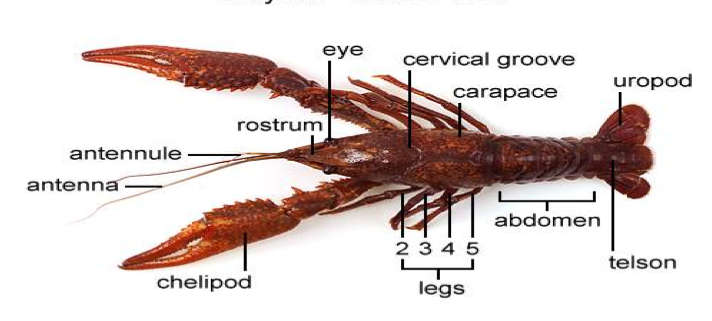 Bilateral symmetryExoskeleton composed mostly of chitin. Made hard by CaCO3. Has to molt.Body regions - Cephalothorax=head+thorax (which are covered by the carapace and divided by the cervical groove)a) antennule - b) Antennac) Chelipodd) Walking legse) Abdomenf) Telsong) uropodh) carapacei) Cervical groovej) Compound eyek) rostrum |
|
Crayfish AppendagesDescription and function.
|
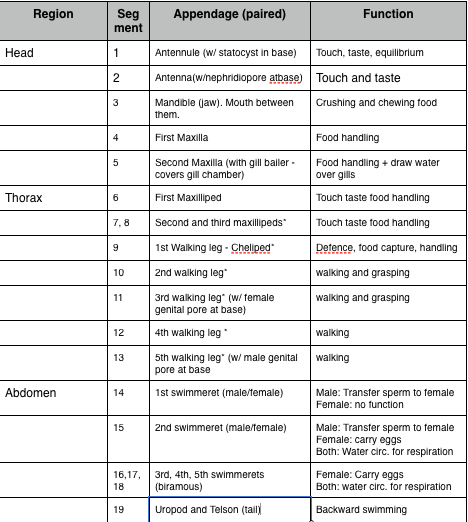 Each segment has 3 parts: basal stalk and 2 distal branches. Therefore they are biramous appendages. REMEMBER: for female there's a seminal receptacle between 4th and 5th walking legs |
|
Serial Homology
|
When there are similar structures in different segments of an organism, perhaps with different functions, it's called serial homology
|
|
Crayfish Respiratory System
|
Gills - some attached to gill chamber (under carapace) Crayfish can breathe on land for a bit because water gets trapped in hereDiffusion of gases
|
|
Crayfish Circulatory System+What carries the oxygen?
|
Open.Heart - in pericardial sinus (dorsal)Heart->arteries (w/ valves) -> Hemocoel (space filled w/ blood) -> Gills -> sinuses -> Pericardial sinus -> ostia (w/ valves) -> heart.Hemocyanin - oxygen carrying pigment in blood plasma of arthropods
|
|
Crayfish Reproductive System
|
External.Male - sperm: Testes -> seminal ducts -> genital pores (5th pair walking legs)Female - Eggs: Ovary -> oviduct -> genital pores (3rd pair walking legs). Seminal Receptacle between 4th and 5th pair of walking legs.
|
|
Male crayfish vs. female crayfish
|
Males: 1st and 2nd pairs of swimmerets hard and useful. 5th walking legs have genital poresFemales: 1st and 2nd pairs of swimmerets soft. 3rd walking legs have genital pores. Seminal receptacle between 4th and 5th pair of walking legs
|



